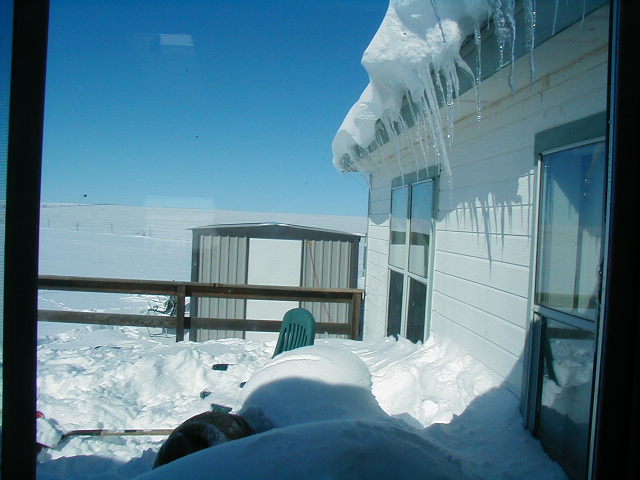
Late Winter-Early Summer 2005
We had a fairly wet spring with lots of wind. For the first time since I've been here, tumbleweeds were a problem. I had some photos of them, but they seem to be lost somewhere on my hard-drive. Needless, the weeds stacked up on the fences and either knocked them down or pushed underneath and pulled the posts out of the ground. We did a lot of fence repair in early spring. Some folks lost 4-8 miles of fence- we only had to rebuild about 1 mile all in all.

Above: Here's some March weather for ya. Lots of moisture in that snow.
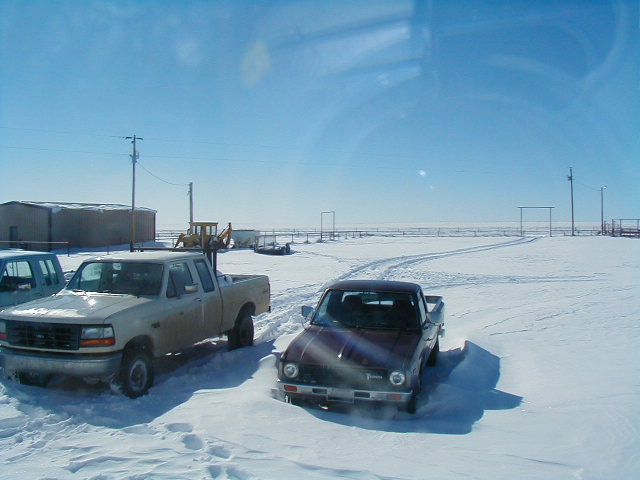
Above: I didn't do a lot of driving around, as you can see- just went for the mail and that was about it. Worked on guitars, otherwise.
Cattle came in a little late, not arriving until May and were turned out to pasture. It took a full 5 weeks to get all the cattle in. Everything was looking good and then Trouble reared its ugly head. In mid-June, just as I was getting ready to leave for Kaufman Kamp 2005, my #1 well went down. The problem was diagnosed as "sanding-in". This is where the pipe above the well corrodes and allows sand/dirt to fall down upon the pump. We tried to pull the pump and the water pipe snapped, leaving a $1000 pump lost forever at the bottom of a 310' well. This was not looking good, as this pump feeds 8 tanks in 3 different pastures and well drilling isn't cheap
I have a generator hooked up to a submersible well that can back-pump into the pipeline, so I got that working after some difficulty. Turns out that both of my generators were having trouble, but I finally got one working well enough that I could leave Georgia for a week and go to TN to Kamp. Adding to my troubles was a lack of moisture- it hadn't rained since March/April and things were looking pretty dry in the creeks and potholes. I scrambled to get my water truck in shape with decent tires and got the water pump rigged up so that Georgia could pump water if need be. I pumped for several days and then filled 2 of the major tanks (3,000 and 5,000 gallons) with water clear to the brim the night before leaving for TN.
Above: Here's my water pumping rig. I'd go to windmills and pump water from them. This mill was the closest to my main tank and draining it filled the blue tanker almost exactly. The blue tanker holds 750 gallons and the target tank is 3,000 gallons, so we're looking at a minimum of 3-4 loads to fill it. It takes the windmill about 4 hrs to refill this tank, so I couldn't re-pump it immediately, but had to go to a different windmill. Trips took about 1 to 1.5 hours from start to finish.
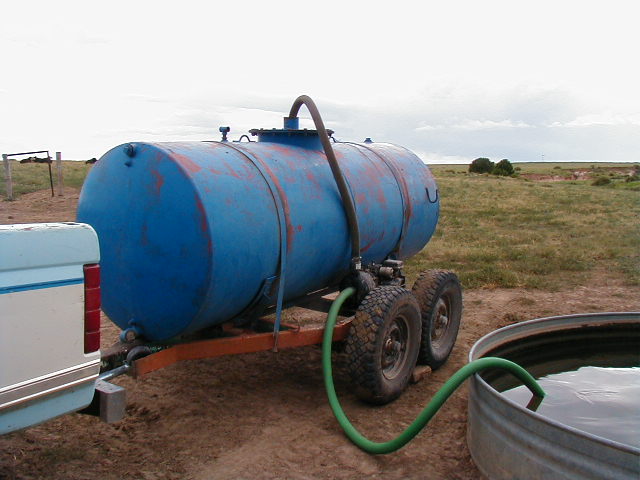
Above: A closeup of the water pump. It's mounted to the trailer and it's fairly easy to swing the suction hose off and into the tank. This is actually July, after I'd gotten the system running a little better. In June, I hadn't mounted the pump and was unloading/loading it in the back of the truck. That got old fast. Once I mounted it to the trailer, things went much faster and easier.
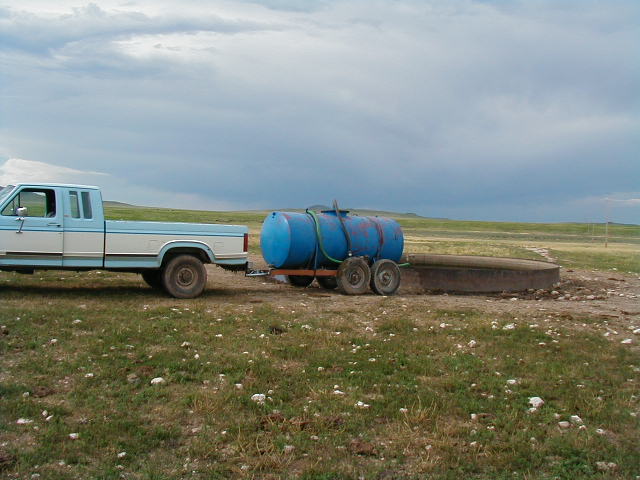
Above: And here I am at the #1 tub, draining water. Storm clouds are on the horizon, bringing some blessed cool temperatures (cattle drink a lot less in cool weather!). It took about 15 minutes to fill the tanker and 20 minutes to drain it. I spent the downtime reading my Bible and playing a CA-X guitar that I bought upon return from Kamp. The pump started working slower and slower and I discovered that the impeller was busted and chipped. An emergency run to Trinidad CO for parts (90 miles each way) got me fixed up, but then I still had to pump my daily 6 hrs of water! That was a long day.
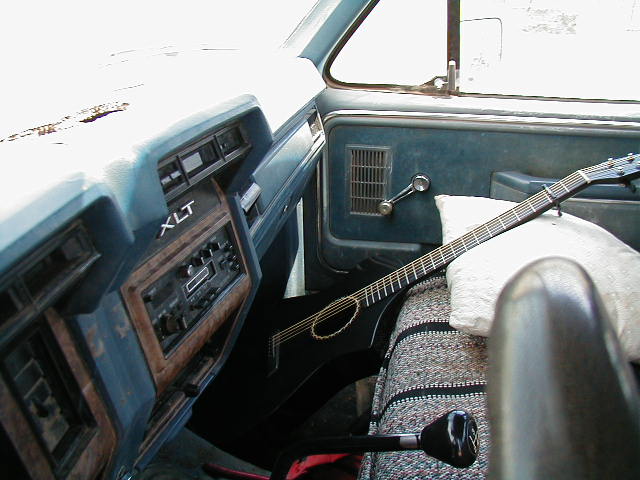
Above: Here's the CA-X in action. I actually didn't play it all that much because it was necessary to get out and check the tanker pretty frequently. I for sure didn't want to lose any of that valuable water!!!
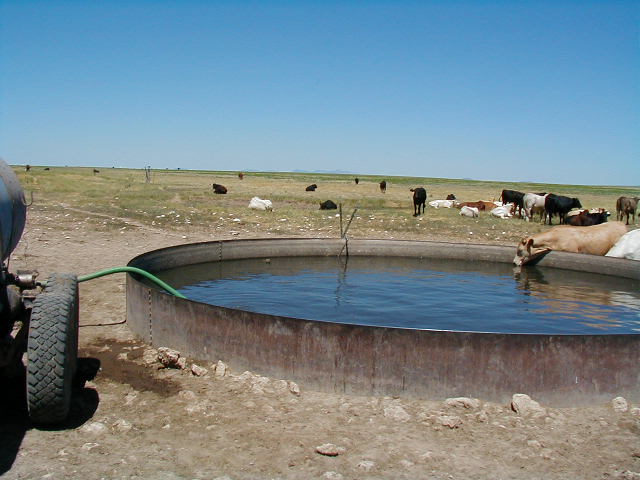
Above: Keeping up with thirsty cattle was tough sometimes. On a hot day like this one (no clouds), I'd bring a load first thing in the morning from the nearby mill (above), then head off to a further mill for the second load. By the time I got back, the cattle had often drank the tank to below the starting level! I was losing ground! I'd make another run to an even further mill for my 3rd load and then quit for lunch. Immediately after lunch, I'd repeat the run. Since the cattle had been drinking all morning (you can seem them lounging around in the background), I could usually catch up a little in the afternoon. Since each run took 1 to 1.5 hours, we're looking at 4 to 8 hours of doing nothing but hauling water. If I had truck, trailer, or pump problems, I had to fix them as fast as possible and get back to hauling water. There were several times when I hauled my first load at 6 am and my last load at 9 pm. This, of course, created a lot of stress where my guitar business was concerned! I just absolutely could not do it all, esp. during the first month when I was scrambling to get things running.
In addition to trying to keep the water up, several of my tanks were becoming severely eroded and in danger of being undercut by erosion. You can see just a little of this in the shot above where the bottom of the tank is showing. Also, note how the drinking steer's neck is rubbing on the tank- they don't like that and as a result, tend to jump into the tank. Steers are not potty trained very well and the tank will quickly become little more than a cesspool. Adding to this is the disturbance caused by draining water into the tank. The force from the hose stirs up all the bottom muck and doesn't let it settle. Before long, this tank was stinking.
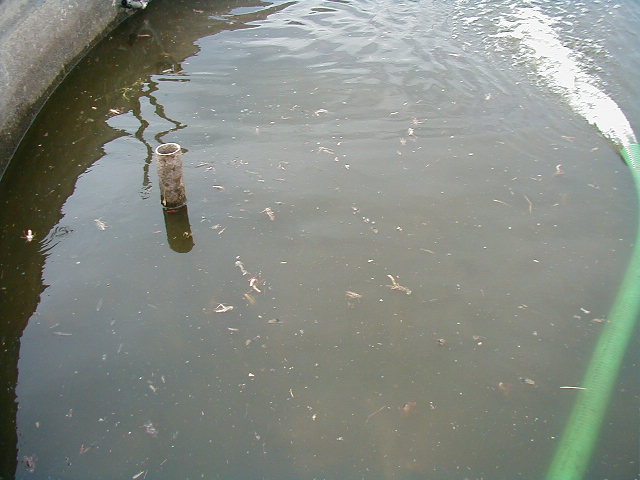
Above: And then, then grasshopper plague came...the grasshopers were just absolutely unbelievable this year. In some places, it looked like the ground was moving. They, of course, were attracted to the water and would fly into the tank and drown. I had to do something.
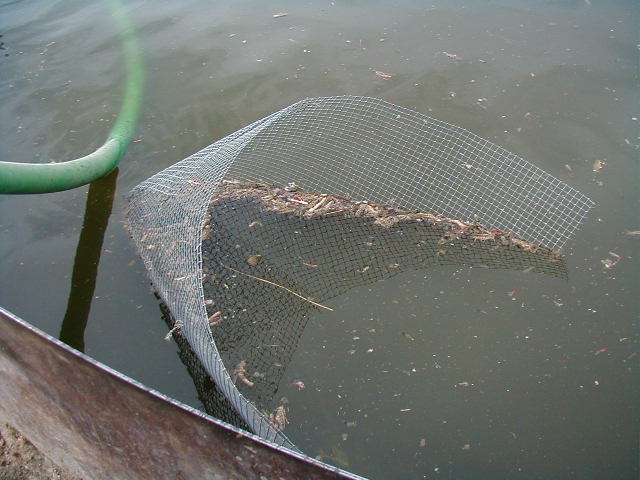
Above: As I was pumping water, I noticed that if I laid the hose along the tank that it would push the dead hoppers into a stream and circulate them around the tank. So, I rigged up this simple little funnel and started filtering out grasshoppers. The first time I did this, I filled this funnel full of grasshoppers clear back to the opening! I pulled probably 5 lbs of grasshoppers the first time. This accumulation is later on, after I got the tank semi-clean and this the number of hoppers that I typically scooped every single time I filtered the tank, which was, every load. It was still dry, too.
Ranch 2005: Part 2